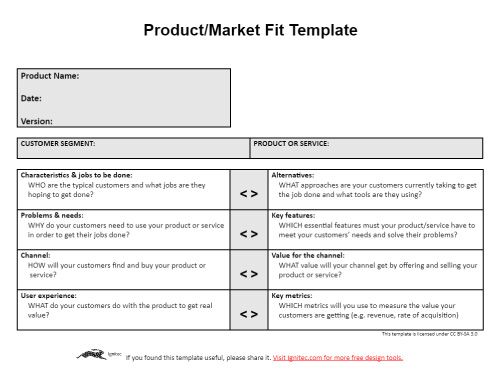We are an award winning product design consultancy, we design connected products and instruments for pioneering technology companies.
Free product/market fit template to ensure you’re meeting customer needs
Reading time 6 mins
Key Points
- Comprehensive customer research, surveys, and feedback are essential to ensuring that the products you develop provide the solutions your target market is looking for
- Developing a good product/market fit is about finding an underserved need, making a product that fulfils it, and then testing and improving it
- Developing products that fit your target audience helps to reduce customer acquisition costs, increase customer retention, grow and scale your business faster
- Download this free product/market fit template to help you develop a framework you can use to create products that fit
Ready to start developing your new product?
Call us for a quote!
Ben Mazur
Managing Director
I hope you enjoy reading this post.
If you would like us to develop your next product for you, click here
Following up on using a product vision board for user-centred design is doing comprehensive customer research to ensure your product will fit the right market. Analysing your product market fit helps you to understand the severity of the problem consumers have, whether your product provides a solution they’re looking for and whether they’ll be willing to pay for it. Our product/market fit template will help you compile the information needed to measure that what you built is something people want.
Ideally, you want to release a product that does its job so well that your target market becomes its greatest advocate, and your customers sell it for you (e.g. via word of mouth, reviews, and social media posts).
 Product/market fit
Product/market fit
Download our free template
Why is having a good product market fit important?
“The most common mistake startups do is to solve a problem no one has.” – Paul Graham (computer scientist and venture capitalist)
Other than helping you avoid making this mistake, a good product market fit will also help you:
- Reduce your promotional and customer acquisition costs because your customers are doing most of your marketing for you
- Improve customer retention
- Grow your business faster
- Scale your business when the time is right
When should you use a product/market fit template?
Initially developed by The Business Model Analyst, this template provides a framework to find the ideal product market fit. Although its primary intention is to help verify that your product meets customer needs, you can also use it at various stages of your company’s growth. For example:
- Identify your target customers: Who are you making the product for? What is their age, occupation, geographic location, income group etc.?
- Identify your customer’s pain points: What are your target market’s problems, and how do they affect them? What kind of solution are they looking for, and does a similar one already exist on the market?
- Describe your value proposition: How will your product benefit customers and make their lives easier?
- Define, make, and test your minimum viable product (MVP): This is a minimum-cost sample version with just enough features to be usable by early customers and a test-market audience. Prepare a diverse set of questions and surveys for your customers to get unbiased feedback and use that to refine the product’s features. For example: How would you feel if you could no longer use this product? How could it be improved? What are the main benefits you received? Would you use an alternative if this product were no longer available?
If the feedback you receive doesn’t give you the reaction you’re looking for, take another look at how you identified your customer’s pain points. How can the product be changed or modified to serve the market better? Were there any loopholes or bugs, and how can you fix them?
Are you ready to get started?
If you still need to do so, download our product/market fit template and fill out each section with as much detail as possible. Please share it with your team and collaborate to ensure your analysis is headed in the right direction. Consider including another brainstorming session to work through any new ideas that arise.
The metrics you use are essential to analysing the data you receive and ensuring you have a good market fit. This can be done by measuring your customer acquisition rate (i.e. how quickly customers buy your product), sales revenue, the number of referrals you receive, and customer retention. Retention is seen as the most accurate way of measuring your market fit, and as a general rule of thumb for customer retention and market fit, you want this to be at least 40%.
Feel free to modify the template as/when your needs change. Once you’ve found a viable product and a good market fit, you’ll be ready to bring it to market. Read our blog on how to bring your product to market quickly in 5 steps, and use our free product roadmap to stay goal-oriented!
Did you find this template helpful?
Developing a good product/market fit is about finding an underserved need, making a product that fulfils it, and testing and improving it. We hope this template helps you do that and successfully brings your product to market!
Let us know how you got on, and leave a comment below. Sign up for our newsletter for more business development insights or free user templates for startups.
Comments
References
- Warzecha, L. (2023, January 17). IoT Trends for 2023. ITSG Global. https://itsg-global.com/iot-trends-for-2023/
- All, I. F. (2023, March 13). How IoT Will Change in 2023. IoT for All. https://www.iotforall.com/podcasts/e270-how-iot-will-change-in-2023
- The Fourth Industrial Revolution: what it means and how to respond. (2020, September 22). World Economic Forum. https://www.weforum.org/agenda/2016/01/the-fourth-industrial-revolution-what-it-means-and-how-to-respond/
- Humblot, N. (2021, December 2). IoT and sustainable development. Ryax Technologies. https://ryax.tech/iot-and-sustainable-development/
Get the print version
Download a PDF version of our article for easier offline reading and sharing with coworkers.


 Product/market fit
Product/market fit
0 Comments